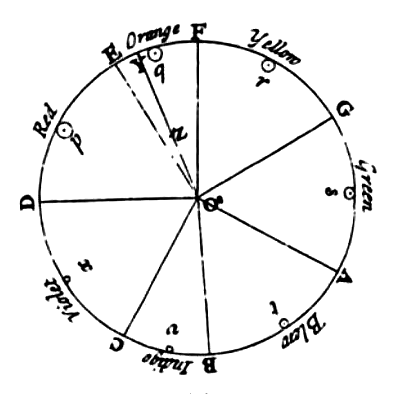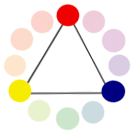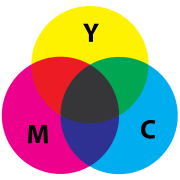Color theory basics - part 1: Subtractive vs. additive color The color wheel - By definition a color wheel or color circle is an organization of color hues around a circle, showing relationships between colors considered to be primary colors, secondary colors, complementary colors and so on. Color theory is a set of principles used to create harmonious color combinations. Color relationships can be visually represented with a color wheel -- the color spectrum wrapped onto a circle. The color wheel history - It is noted in history that Sir Isaac Newton conceptualized the first color wheel in 1666 when Newton split white sunlight into red, orange, yellow, green, cyan and blue beams using a prism. He then joined the two ends of the color spectrum together to show the natural progression of colors. Newton associated each color with a note of a musical scale. If only this comprehension of the color spectrum meant I could read music as well. Today not many know Newton associated the color spectrum with musical notes but we still consider the composition of both as art.

Note how Newton’s color wheel above attributes color spectrums with musical notes.
Artists typically use red, yellow and blue primaries (see color model below), so these are arranged at three equally spaced points around their color wheel.

Red, yellow and blue are primary colors. These colors when mixed together in varying ratios can create a full-color spectrum.
Printers and others who use modern subtractive color methods and terminology use magenta, yellow and cyan as subtractive primaries (see color model below).

A subtractive color wheel consisting of cyan, magenta and yellow.
Color scientists and psychologists often use additive primaries such as red, green and blue, and often refer to their arrangement around a circle as a color circle, as opposed to a color wheel. In the design world the difference between subtractive and additive primaries is the difference between a printed page, subtractive color of CMYK and a monitor or television screen, additive primaries of RGB. The arrangement of colors around the color wheel is often considered to be in correspondence with the wavelengths of light, as opposed to hues, in accord with the original color circle of Newton. Modern color circles include the ultraviolet purples, however, between red and violet. Intermediate and interior points of color wheels and circles represent color mixtures. In a paint or subtractive color wheel, the center is usually (but not always) black (sometimes this is represented as brown), representing all colors of light being absorbed; in an additive color circle, on the other hand, the center is white or gray, indicating a mixture of different wavelengths of light (all wavelengths, or two complementary colors, for example). Now that you know the history and the two different definitions of the color wheel or circle we will explore color further in
Part 2: Color wheel relationships and groupings.












[...] « Previous Post [...]
I follow your blog for quite a lengthy time and have to have tell that your content articles often prove to be of a high value and high quality for readers.
Websites you should visit...
[...]below you’ll find the link to some sites that we think you should visit[...]…...